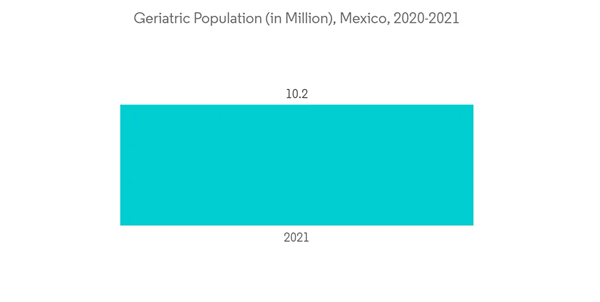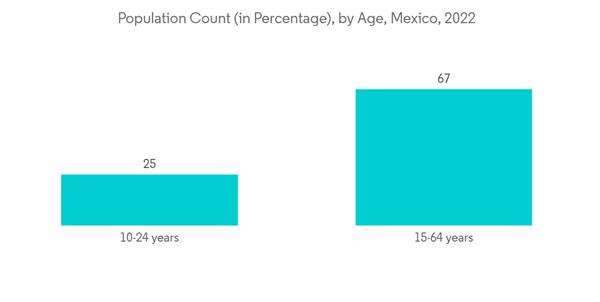The COVID-19 pandemic posed severe challenges to healthcare systems. The market was primarily controlled by drastically cutting down in- and out-patient services for dental diseases and implementing infection prevention and control measures. The lockdown in the country affected the supply chain of dental devices and equipment. According to an article published in the International Journal of Environmental Research and Public Health in February 2021, it was observed that 67.9% of dentists in Mexico were attending only dental emergencies. 14.8% of dentists chose not to attend to any patients during the pandemic lockdown. The oral healthcare providers in the country took safety measures to avoid contamination by the coronavirus. However, there was still an increased risk of infection for oral healthcare providers. Thus, the country's delayed diagnosis and treatment of dental diseases impacted the demand for dental devices, slowing the market growth. However, as the COVID-19 cases declined, leading to fewer restrictions, dental services in the country resumed, and increased patient visits contributed to the market growth. The market is expected to follow stable growth over the next 3-4 years.
Currently, factors such as increasing awareness about oral care, rising incidences of dental diseases, and growing innovation in dental products are boosting market growth.
The burden of dental caries due to unhealthy eating and lack of oral care is increasing among the population, which is the key factor driving the market growth. As per an article published in Medicine Journal in June 2021, a cross-sectional survey of school children aged 8 to 12 from various socio-economic backgrounds was conducted in 2020 in Mexico. It was found that the prevalence of non-cavitated lesions among the children was 38.0%, cavitated lesions were 43.4% in permanent dentition, and 50.6% of school children had poor oral hygiene. According to the same source, low brushing frequency and poor dental hygiene were the main factors responsible for dental cavities among Mexican children. The high burden of dental cavities increases the risk of tooth loss. This is expected to fuel the need for dental implants or crowns, propelling the market growth.
In addition, the presence of a high-quality healthcare system, partially funded by the government and partially supplemented by private health providers in the country, contributes to the market's growth. The country has two public health insurance institutes, the Instituto de Salud para el Bienestar (INSABI) and the Instituto Mexicano del Seguro Social (IMSS). Also, all the residents in the country must have private health insurance, which covers basic dental procedures, such as annual check-ups, cleaning, and caries treatment.
Therefore, the studied market is expected to grow over the forecast period due to the aforementioned factors, such as the burden of dental and oral diseases and the high quality of the healthcare system. However, the high cost of dental surgeries and implant devices will likely impede the growth of the Mexican dental devices market over the forecast period.
Mexico Dental Devices Market Trends
Prosthodontic Segment Expected to Witness Growth
The prosthodontic segment is expected to witness significant growth in the Mexican dental devices market over the forecast period owing to the higher adoption of prosthetics, the presence of a well-established healthcare system, and reimbursement policies.As prosthodontic dentistry has a wide range of tools used for dental corrections, there is a massive application of prosthodontic equipment. There is an increasing demand for dental prostheses across developing and developed nations due to the rising number of older adults. As per an article published in the International Dental Journal in October 2021, more than half of the population has at least one missing tooth in Mexico. The number of missing teeth is higher in individuals with diabetes and unhealthy habits such as smoking. This is anticipated to increase the demand for prosthodontics, propelling the market growth.
The rising geriatric population is more prone to develop periodontal diseases, which slowly wear down the supporting tissues in the mouth, often leading to tooth loss. This is expected to increase the demand for artificial teeth, propelling the market growth. According to an article published in PLOS One in July 2021, about 1 in 5 adults aged 65 or older have lost all of their teeth. As per the same source, the prevalence of complete tooth loss was more common among the population aged 75 years and older. According to the 2022 statistics published by the UNPF, about 67% of the people in Mexico were aged 15-64 in 2022, while 8% of the population was 65 years and above.
Therefore, the studied segment is expected to grow over the forecast period due to the aforementioned factors, such as the rising prevalence of periodontal diseases coupled with the increasing geriatric population in the country.
Crowns and Bridges Segment Expected to Own Significant Market Share
The dental crowns and bridges segment is expected to witness significant growth over the forecast period owing to the factors such as the increasing burden of dental diseases and tooth loss among the population, along with the rising advancements in dental device technology.A dental crown covers the damaged tooth, restores its shape, size, and strength, and improves its overall appearance. A dental bridge fills the gap created by one or more missing teeth. Two or more crowns are used as a bridge to cover the teeth on either side of the gap. After examining each tooth, the dentist takes an impression of each tooth to create a precise mold for the crown or bridge.
Some emerging advanced technologies include computer-aided design and computer-aided manufacturing (CAD/CAM) to develop dental crowns and implants, shorter waiting periods, and minimized outsourcing costs. These benefits are expected to increase its adoption in the dental industry, propelling the market growth. According to an article published in NCBI in August 2021, ceramics are now primarily used in dental implant dentistry to restore lost teeth. There is a rising demand for dentistry and tooth color restorations. Bi-layered ceramic restorations are preferred because of their propensity to resemble the structure of human enamel and dentine. They also ensure fracture resistance. There is also an increasing trend for aesthetic procedures for teeth among adults and the elderly population in the country.
Therefore, the emerging advanced technology for developing crowns and bridges and increasing tooth problems, such as cavities and tooth loss, are expected to increase segment growth over the forecast period.
Mexico Dental Devices Market Competitor Analysis
The Mexican dental devices market is fairly competitive, with the presence of key players in the market. The companies are adopting various business strategies, such as product launches, acquisitions, partnerships, etc., to withhold their market positions. Some of the key players in the dental devices market in Mexico are Kerr Corporation, Envista Holdings Corporation, Zimmer Biomet, Danaher Corporation, 3M, and Dentsply Sirona, among others.Additional benefits of purchasing the report:
- The market estimate (ME) sheet in Excel format
- 3 months of analyst support
This product will be delivered within 2 business days.
Table of Contents
Companies Mentioned (Partial List)
A selection of companies mentioned in this report includes, but is not limited to:
- 3M
- Envista Holdings Corporation
- Kerr Corporation
- Dentsply International Inc.
- Straumann Holding AG
- Zimmer Biomet
- Sirona Dental Systems Inc.
- Kulzer Mexico










